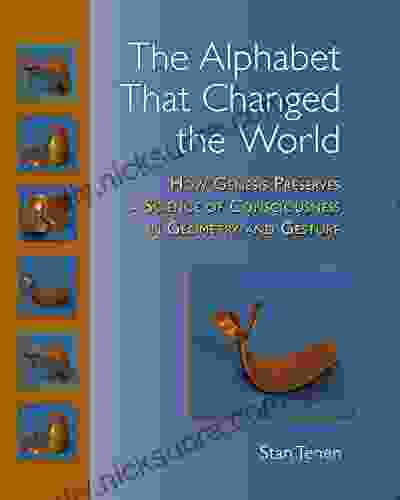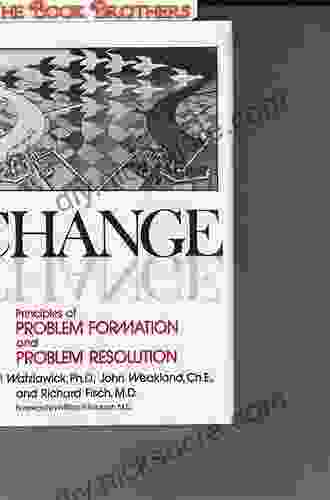Change Principles Of Problem Formation And Problem Resolution

In the face of complex and ever-changing challenges, it is imperative to re-evaluate the conventional principles of problem formation and resolution. Traditional approaches often fall short in addressing the intricate nature of modern-day problems, leading to suboptimal outcomes and missed opportunities.
To navigate these complex landscapes, we must embrace innovative principles that empower us to define problems more effectively, identify underlying root causes, and develop tailored solutions. This article explores these transformative principles, providing a roadmap for enhanced problem-solving capabilities in both personal and organizational contexts.
4.4 out of 5
| Language | : | English |
| File size | : | 629 KB |
| Text-to-Speech | : | Enabled |
| Screen Reader | : | Supported |
| Enhanced typesetting | : | Enabled |
| Word Wise | : | Enabled |
| Print length | : | 201 pages |
1. Shift from Symptom to Root Cause Analysis
Traditional problem-solving approaches tend to focus on addressing immediate symptoms rather than digging deeper to uncover underlying root causes. This superficial approach often results in temporary fixes that fail to prevent recurrence.
Root cause analysis, on the other hand, involves a systematic investigation to identify the fundamental factors contributing to the problem. By addressing the root cause, we can prevent the problem from resurfacing and develop sustainable solutions.
2. Embrace Multi-Dimensional Perspectives
Problems are rarely isolated phenomena; they often involve a complex interplay of factors from various domains. Traditional problem-solving approaches may overlook these interconnections, leading to narrow and ineffective solutions.
Multi-dimensional perspectives encourage us to consider the problem from different angles, taking into account social, economic, environmental, and psychological factors. This holistic approach fosters comprehensive and durable solutions.
3. Foster Collaboration and Diversity
Problem-solving should not be confined to a single individual or team. Collaboration brings together diverse perspectives, experiences, and expertise, enhancing the quality of ideas and solutions.
Fostering diversity in problem-solving groups leads to a broader range of perspectives and innovative insights. Inclusive environments encourage open dialogue, challenge assumptions, and ultimately lead to more effective solutions.
4. Utilize Design Thinking Principles
Design thinking is an iterative problem-solving process that emphasizes user-centricity, ideation, and prototyping. Incorporating design thinking principles into problem formation and resolution enables us to:
- Develop solutions that meet the needs of stakeholders
- Test and refine ideas through iterative prototyping
- Foster a creative and collaborative problem-solving environment
5. Leverage Technology for Problem-Solving
Technological advancements offer powerful tools for problem-solving. Data analytics, machine learning, and artificial intelligence can assist in:
- Identifying patterns and underlying trends
- Predicting future outcomes and potential risks
- Automating certain aspects of problem-solving
Technology can complement human capabilities, enhancing the efficiency and effectiveness of problem-solving efforts.
6. Promote a Culture of Learning and Adaptation
Problem formation and resolution is an ongoing process that requires continuous learning and adaptation. Organizations and individuals must foster a culture that values knowledge acquisition, experimentation, and feedback.
By embracing a learning mindset, we can continually refine our problem-solving approaches, adapt to changing circumstances, and stay ahead of emerging challenges.
Changing principles of problem formation and resolution is not merely about adopting new techniques; it is about rethinking our entire approach to problem-solving. By embracing innovative principles, we can empower ourselves to define problems more effectively, identify root causes, develop tailored solutions, and navigate the complexities of the modern world.
Remember, the journey to effective problem formation and resolution is an iterative process that requires collaboration, learning, and a willingness to challenge the status quo. By embracing these principles, we can unlock the potential for transformative problem-solving and achieve lasting success.
4.4 out of 5
| Language | : | English |
| File size | : | 629 KB |
| Text-to-Speech | : | Enabled |
| Screen Reader | : | Supported |
| Enhanced typesetting | : | Enabled |
| Word Wise | : | Enabled |
| Print length | : | 201 pages |
Do you want to contribute by writing guest posts on this blog?
Please contact us and send us a resume of previous articles that you have written.
 Fiction
Fiction Non Fiction
Non Fiction Romance
Romance Mystery
Mystery Thriller
Thriller SciFi
SciFi Fantasy
Fantasy Horror
Horror Biography
Biography Selfhelp
Selfhelp Business
Business History
History Classics
Classics Poetry
Poetry Childrens
Childrens Young Adult
Young Adult Educational
Educational Cooking
Cooking Travel
Travel Lifestyle
Lifestyle Spirituality
Spirituality Health
Health Fitness
Fitness Technology
Technology Science
Science Arts
Arts Crafts
Crafts DIY
DIY Gardening
Gardening Petcare
Petcare Loretta Sponsler
Loretta Sponsler Ray Ordorica
Ray Ordorica Matt Brown
Matt Brown Philip Yarrow
Philip Yarrow Peter Rees
Peter Rees Dr Stephanie Bloodworth Psyd
Dr Stephanie Bloodworth Psyd Chris I Naylor
Chris I Naylor John Williams
John Williams Anghel Leonard
Anghel Leonard Rysa Walker
Rysa Walker A J Messenger
A J Messenger Marcus Butler
Marcus Butler Michael Lardon
Michael Lardon Jim Allen
Jim Allen Roxanne Martin
Roxanne Martin Joe Navarro
Joe Navarro William Minto
William Minto Jm Mason
Jm Mason Elisabeth Fassas
Elisabeth Fassas Michael Shingleton
Michael Shingleton Dawn Huebner
Dawn Huebner John L Messina
John L Messina Bear Heart
Bear Heart Erin Watt
Erin Watt Sherrilyn Kenyon
Sherrilyn Kenyon Sky Marsen
Sky Marsen Diane Burke Fessler
Diane Burke Fessler Dane Huckelbridge
Dane Huckelbridge Alison Cotter
Alison Cotter Leigh Newman
Leigh Newman Anji Andrews
Anji Andrews Sandra Swenson
Sandra Swenson Eric Blehm
Eric Blehm Jennifer Trainer Thompson
Jennifer Trainer Thompson Hazel Holmes
Hazel Holmes Jane Austen
Jane Austen Philip Golding
Philip Golding Michelle Maccarthy
Michelle Maccarthy Gemma Milne
Gemma Milne A L Graziadei
A L Graziadei Zen Faulkes
Zen Faulkes Tripp Bowden
Tripp Bowden Rina Kent
Rina Kent William F Mann
William F Mann Tom Jordan
Tom Jordan Dmv Test Bank
Dmv Test Bank Kenneth Cline
Kenneth Cline Aaron Kleinmeyer
Aaron Kleinmeyer Seth M Holmes
Seth M Holmes Eva Mauer
Eva Mauer Jeff Kane
Jeff Kane A Roger Ekirch
A Roger Ekirch Marc S Sabatine
Marc S Sabatine Homeira Qaderi
Homeira Qaderi Roy Richard Grinker
Roy Richard Grinker Joe Pepitone
Joe Pepitone Kenneth Cloke
Kenneth Cloke Eugene Don
Eugene Don John L Parker Jr
John L Parker Jr Linda Tuhiwai Smith
Linda Tuhiwai Smith Pete Ripmaster
Pete Ripmaster A K Davidson
A K Davidson Natalie Pompilio
Natalie Pompilio Patrick Meechan
Patrick Meechan Ari Tuckman
Ari Tuckman Kelly Starrett
Kelly Starrett Val Mcdermid
Val Mcdermid Susan Striker
Susan Striker Lilith Mclelland
Lilith Mclelland David Magee
David Magee Okina Baba
Okina Baba W Timothy Gallwey
W Timothy Gallwey Mia Kankimaki
Mia Kankimaki Ilya Ru
Ilya Ru John Long
John Long Todd Downs
Todd Downs Glenn Patron
Glenn Patron Todd Rose
Todd Rose Russell Davis
Russell Davis Dan Limbaugh
Dan Limbaugh Dr Kevin Leman
Dr Kevin Leman Steven Raichlen
Steven Raichlen Steve Angers
Steve Angers Lou Tabory
Lou Tabory Richard Heath
Richard Heath Rebecca Black
Rebecca Black Dean R Johnson
Dean R Johnson Boston T Party
Boston T Party Shanterra Mcbride
Shanterra Mcbride Alf Wilkinson
Alf Wilkinson Mark Ryan
Mark Ryan Mj Porter
Mj Porter Steve Hindman
Steve Hindman Judi Garman
Judi Garman Thomas Hager
Thomas Hager Rebecca Pelky
Rebecca Pelky Susan Aud Sonders
Susan Aud Sonders Grady Hendrix
Grady Hendrix Nancy Mckenzie
Nancy Mckenzie Andrea Falk
Andrea Falk Ed Webster
Ed Webster Dr Alan Whitcomb
Dr Alan Whitcomb Soap2day Publication
Soap2day Publication Din Daniels
Din Daniels Zander Brumbaugh
Zander Brumbaugh Matthieu Ricard
Matthieu Ricard Diane Stresing
Diane Stresing Bruce Collier
Bruce Collier Sandra Niche
Sandra Niche Shauna Lynn Panczyszyn
Shauna Lynn Panczyszyn Amos Yong
Amos Yong Blair Holden
Blair Holden Laura Pohl
Laura Pohl Sharie King
Sharie King Nick Jackson
Nick Jackson David A Wells
David A Wells Charles Edward Chapel
Charles Edward Chapel Ray Bradbury
Ray Bradbury Oba Ilari Aladokun
Oba Ilari Aladokun Jennifer Longmore
Jennifer Longmore Peter Goldenthal
Peter Goldenthal A J Hamler
A J Hamler Jec Aristotle Ballou
Jec Aristotle Ballou Tammara Webber
Tammara Webber Dave Lowry
Dave Lowry Bruce Tremper
Bruce Tremper Monte Burke
Monte Burke Thomas R Martin
Thomas R Martin Timothy C Urdan
Timothy C Urdan Joseph Mctaggart
Joseph Mctaggart Gordon Macquarrie
Gordon Macquarrie Michael Lanza
Michael Lanza William Bauer
William Bauer Anna Goldsworthy
Anna Goldsworthy Daniel S Pierce
Daniel S Pierce Cassandra Clare
Cassandra Clare Gabrielle Coleman
Gabrielle Coleman Jon Gillespie Brown
Jon Gillespie Brown Raymonde Carroll
Raymonde Carroll Arlin Smith
Arlin Smith Susanne Foitzik
Susanne Foitzik Jordan B Peterson
Jordan B Peterson John Halligan
John Halligan John Almberg
John Almberg Nicole Conway
Nicole Conway Helen Fitzgerald
Helen Fitzgerald Lindsey Lapointe
Lindsey Lapointe Jennifer L Armentrout
Jennifer L Armentrout Helen Marot
Helen Marot Barry Werth
Barry Werth Alexander Greenmaj
Alexander Greenmaj Russell Sher
Russell Sher Adam Savage
Adam Savage King Solomon
King Solomon Shelly Mazzanoble
Shelly Mazzanoble Mrjamvad
Mrjamvad Thomas Mcguane
Thomas Mcguane Jim Vernes
Jim Vernes Alyssa Padgett
Alyssa Padgett Cathy A Malchiodi
Cathy A Malchiodi Taha Sochi
Taha Sochi Fernanda Pirie
Fernanda Pirie N J Enfield
N J Enfield Iasha King
Iasha King A J Mackinnon
A J Mackinnon Jonathan Eig
Jonathan Eig Sarah Sutton
Sarah Sutton Raymond J Carroll
Raymond J Carroll Anne Deans
Anne Deans Chris Diamond
Chris Diamond Carrie Harper
Carrie Harper Virginia Willis
Virginia Willis Ken Castor
Ken Castor Rens Bod
Rens Bod Lyndall Clipstone
Lyndall Clipstone Lillian Tibbles Phd
Lillian Tibbles Phd Gary Gruber
Gary Gruber Caspar Craven
Caspar Craven Akash Kapur
Akash Kapur Meghan Leahy
Meghan Leahy Jean Philippe Dionne
Jean Philippe Dionne William Ramsey
William Ramsey Raymond M Smullyan
Raymond M Smullyan Noah Gift
Noah Gift Heather Gudenkauf
Heather Gudenkauf Karl Knopf
Karl Knopf Paul Mccarthy
Paul Mccarthy Pardha S Pyla
Pardha S Pyla Emily Evans
Emily Evans A J Carlisle
A J Carlisle Mandy Rivers
Mandy Rivers Vernon Trafford
Vernon Trafford Kerri Hummingbird Sami
Kerri Hummingbird Sami Rebecca A Moyes
Rebecca A Moyes James Baldwin
James Baldwin Cynthia Ulrich Tobias
Cynthia Ulrich Tobias Ridge Magee
Ridge Magee A R Vasishtha
A R Vasishtha Dan Romanchik Kb6nu
Dan Romanchik Kb6nu Katrina Abbott
Katrina Abbott K A Riley
K A Riley Randy Friedman
Randy Friedman A F Stewart
A F Stewart Dale P Clemens
Dale P Clemens Andreas Quast
Andreas Quast Stan Tenen
Stan Tenen Jennie Finch
Jennie Finch Chuck Whelon
Chuck Whelon Brian Clegg
Brian Clegg E S Wynn
E S Wynn Joel David Hamkins
Joel David Hamkins Jamie Vardy
Jamie Vardy Alex Karp
Alex Karp Harry Yoon
Harry Yoon Francis Pryor
Francis Pryor Eric Sevareid
Eric Sevareid Christiane Kutik
Christiane Kutik Helen E Johnson
Helen E Johnson Peter Zheutlin
Peter Zheutlin Val Emmich
Val Emmich A M Wilson
A M Wilson Adrian Dater
Adrian Dater Rick Telander
Rick Telander David Remnick
David Remnick Kathy Koch
Kathy Koch Larit Levy
Larit Levy Susan Cooper
Susan Cooper Lucy Christopher
Lucy Christopher Jack Grimshaw
Jack Grimshaw Kevin Adams
Kevin Adams Sergey Kosarevsky
Sergey Kosarevsky Sherine Hamdy
Sherine Hamdy Christine Wheeler
Christine Wheeler Day Leitao
Day Leitao Frost Kay
Frost Kay Lou Zambello
Lou Zambello Vitaly Pedchenko
Vitaly Pedchenko Timothy J Gawne
Timothy J Gawne A M Strickland
A M Strickland Lauren Muhlheim
Lauren Muhlheim Christopher Small
Christopher Small Armin A Brott
Armin A Brott Bryan Berg
Bryan Berg Sarah Jo Brown
Sarah Jo Brown A H Almaas
A H Almaas Tiara R Brown
Tiara R Brown A G Howard
A G Howard Max Tegmark
Max Tegmark Charles Szypszak
Charles Szypszak Robert P Harris
Robert P Harris Marlynn Jayme Schotland
Marlynn Jayme Schotland Matthew J Friedman
Matthew J Friedman Mike Tidwell
Mike Tidwell Heather Anderson
Heather Anderson Mike Branon
Mike Branon Todd Wanerman
Todd Wanerman Todd Gitlin
Todd Gitlin Bob Frye
Bob Frye John D Currid
John D Currid Eileen Tracy
Eileen Tracy Niall Ferguson
Niall Ferguson Anne Sigismund Huff
Anne Sigismund Huff Yasu
Yasu Tanya Selvaratnam
Tanya Selvaratnam George Francis Dow
George Francis Dow Mark Obmascik
Mark Obmascik Roger Zelazny
Roger Zelazny Giordano Scalzo
Giordano ScalzoA G
 Bruce Lansky
Bruce Lansky Catherine Stonehouse
Catherine Stonehouse Ryan Gray
Ryan Gray The R A
The R A Filippo Coarelli
Filippo Coarelli Jan Morris
Jan Morris Amanda Ostrander
Amanda Ostrander Helen Buckley
Helen Buckley Jamal Moustafaev
Jamal Moustafaev Tim Flanagan
Tim Flanagan Lilin Yang
Lilin Yang Saxton Pope
Saxton Pope A G Cairns Smith
A G Cairns Smith Cath Smith
Cath Smith Jonathan Mckee
Jonathan Mckee Winston Starr
Winston Starr Thomas C Tabor
Thomas C Tabor Matilda Ramsay
Matilda Ramsay Byron Pitts
Byron Pitts Marks Prep
Marks Prep Peter Maas
Peter Maas Paul Watzlawick
Paul Watzlawick Manoush Zomorodi
Manoush Zomorodi Francis Fukuyama
Francis Fukuyama Stan Skinner
Stan Skinner Andrew Henderson
Andrew Henderson Michael Labossiere
Michael Labossiere John Brenkus
John Brenkus Lauren Oliver
Lauren Oliver Stephen R Lawhead
Stephen R Lawhead Eric Armstrong
Eric Armstrong Ken Dryden
Ken Dryden Abigail Burd Lcsw Pmh C
Abigail Burd Lcsw Pmh C William C Oakes
William C Oakes Walter Dean Myers
Walter Dean Myers Sonya Chappell
Sonya Chappell David Spiegelhalter
David Spiegelhalter Dr Howard Rankin
Dr Howard Rankin Flo Perry
Flo Perry Chelsea Crockett
Chelsea Crockett Leslie Stager
Leslie Stager Jonalu Johnstone
Jonalu Johnstone Michael Dell
Michael Dell Ken Alder
Ken Alder Sean Skahan
Sean Skahan Louis Jacques Dorais
Louis Jacques Dorais Harrison Fluss
Harrison Fluss Bill Jones
Bill Jones Joshua Akin
Joshua Akin Garret Romaine
Garret Romaine Rafe Esquith
Rafe Esquith Cailin O Connor
Cailin O Connor Freya Hoffmeister
Freya Hoffmeister David J Vanbergen Jr
David J Vanbergen Jr Len Fisher
Len Fisher Barbara J Bain
Barbara J Bain William Monk
William Monk Rekha Ramcharan
Rekha Ramcharan John Mordechai Gottman
John Mordechai Gottman William Scott Wilson
William Scott Wilson Georgia Varozza
Georgia Varozza Don Fink
Don Fink Pintip Dunn
Pintip Dunn David H Barlow
David H Barlow Businessnews Publishing
Businessnews Publishing Angela Himsel
Angela Himsel Rachael Allen
Rachael Allen Lyla Lee
Lyla Lee Shenyang Guo
Shenyang Guo Josh Skeen
Josh Skeen Anthony J Onwuegbuzie
Anthony J Onwuegbuzie Micha Gorelick
Micha Gorelick Calvin L Chou
Calvin L Chou Tony Wright
Tony Wright Corina Morariu
Corina Morariu Olivia Smith
Olivia Smith Leandro Taub
Leandro Taub Valerio Varesi
Valerio Varesi Karla Helbert
Karla Helbert Crystal Cestari
Crystal Cestari Zen Lylah
Zen Lylah Katerina Griffith
Katerina Griffith Kathlyn Gay
Kathlyn Gay Brad K Chambers
Brad K Chambers A J Angulo
A J Angulo Lisa Pease
Lisa Pease Peter Nichols
Peter Nichols Lisa Murphy
Lisa Murphy Certsquad Professional Trainers
Certsquad Professional Trainers David Deutsch
David Deutsch Bob Plager
Bob Plager A L Knorr
A L Knorr R A Mejia
R A Mejia Mitch Landrieu
Mitch Landrieu Megan Vickers
Megan Vickers Rosie Garthwaite
Rosie Garthwaite Peter Godfrey Smith
Peter Godfrey Smith Peter Shelton
Peter Shelton Watt Key
Watt Key Upton Sinclair
Upton Sinclair Tsao Lin E Moy L Ac Msom
Tsao Lin E Moy L Ac Msom Jennifer N Smith
Jennifer N Smith Cyndi Kinney
Cyndi Kinney Polly Moore
Polly Moore Kenn Bivins
Kenn Bivins Scott A Ostrow
Scott A Ostrow Jonathan S Rose
Jonathan S Rose Jose M Forero Bautista
Jose M Forero Bautista Michael D Coogan
Michael D Coogan Dale Dougherty
Dale Dougherty Scientia Media Group
Scientia Media Group Bree Moore
Bree Moore Cristian Salcescu
Cristian Salcescu Linh Phung
Linh Phung Toni Natalie
Toni Natalie Dr Tricia Groff
Dr Tricia Groff A J Mackenzie
A J Mackenzie Hicham And Mohamed Ibnalkadi
Hicham And Mohamed Ibnalkadi Charles Butler
Charles Butler Dirk F Moore
Dirk F Moore Sadie Robertson Huff
Sadie Robertson Huff Catherine Rodgers
Catherine Rodgers Remy Agee
Remy Agee A J Stewart
A J Stewart David G Taylor
David G Taylor Jennifer Senior
Jennifer Senior Sam Warburton
Sam Warburton Bob Trueman
Bob Trueman Lindsey Vonn
Lindsey Vonn Dame Darcy
Dame Darcy Kenay Keira
Kenay Keira
Light bulbAdvertise smarter! Our strategic ad space ensures maximum exposure. Reserve your spot today!
 Neil ParkerFollow ·12.6k
Neil ParkerFollow ·12.6k Federico García LorcaFollow ·17.5k
Federico García LorcaFollow ·17.5k Ian PowellFollow ·7.9k
Ian PowellFollow ·7.9k Ralph Waldo EmersonFollow ·12k
Ralph Waldo EmersonFollow ·12k Gordon CoxFollow ·12.5k
Gordon CoxFollow ·12.5k Caleb CarterFollow ·19.7k
Caleb CarterFollow ·19.7k Miguel NelsonFollow ·17.4k
Miguel NelsonFollow ·17.4k Mark MitchellFollow ·6.2k
Mark MitchellFollow ·6.2k

 Franklin Bell
Franklin BellHow Genesis Preserves Science Of Consciousness In...
The book of Genesis is...

 Ted Simmons
Ted SimmonsAt Day's Close, Night in Times Past
As the sun dips...

 Kenneth Parker
Kenneth ParkerRose Under Fire: Code Name Verity - A Heartbreaking and...
In the annals of...

 Jerry Hayes
Jerry HayesNurturing Massage for Pregnancy: A Comprehensive Guide to...
Pregnancy is...

 Blake Bell
Blake BellFill in the Blank: Word Kind of Animal Farm for Kids and...
This interactive fill-in-the-blank...
4.4 out of 5
| Language | : | English |
| File size | : | 629 KB |
| Text-to-Speech | : | Enabled |
| Screen Reader | : | Supported |
| Enhanced typesetting | : | Enabled |
| Word Wise | : | Enabled |
| Print length | : | 201 pages |













